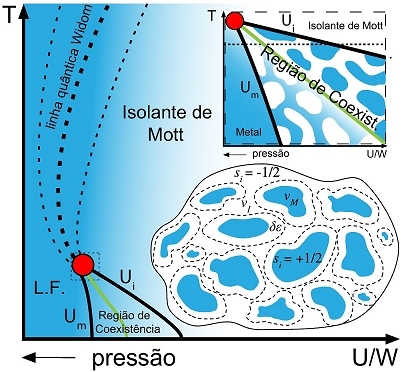

Schematic phase diagram of organic system for temperature T versus U/W xp-1 (where U is Coulomb repulsion and W is bandwidth), showing phases, coexistence region, first-order transition line (green), and critical point (red) (Figure courtesy of researcher Mariano de Souza)
Researchers describe a scenario in which randomly distributed non-polarized metal “puddles” are immersed in a polarized insulating matrix.
Researchers describe a scenario in which randomly distributed non-polarized metal “puddles” are immersed in a polarized insulating matrix.

Schematic phase diagram of organic system for temperature T versus U/W xp-1 (where U is Coulomb repulsion and W is bandwidth), showing phases, coexistence region, first-order transition line (green), and critical point (red) (Figure courtesy of researcher Mariano de Souza)
By José Tadeu Arantes | Agência FAPESP – Phase transitions are part of our everyday lives. The most familiar are water’s phase transitions between solid, liquid, and gas. Scientists have frequently investigated one that is less familiar to most. It is called the “Mott transition” and is named for Nevill Mott (1905-96), an Englishman who won the 1977 Nobel Prize for Physics for his work on semiconductors.
A Mott transition occurs when a metallic system, which has itinerant electrons and hence conducts electric current, becomes an insulator owing to variations in external parameters, such as pressure or doping (composition), for example.
“When the control parameter reaches a critical value, the electrons localize and the insulation phase is established. In short, a genuine Mott metal-insulator transition happens when the ratio between two energy scales, the Coulomb repulsion between electrons and the electronic bandwidth, reaches a critical value,” said Mariano de Souza, a professor in the Rio Claro Physics Department of São Paulo State University (UNESP) in Brazil.
Souza was the principal investigator for a study, published in the Journal of Applied Physics, reporting novel aspects of the Mott transition. The study was supported by FAPESP via a Regular Research Grant for the project “Exploring thermodynamic and transport properties of strongly correlated electron systems”, led by Souza.
“Our study focused on an effort to understand the physics of the metal-insulator coexistence region close to the critical point. In this region, metal ‘puddles’ are embedded in an insulating matrix. There’s a transition line that ends at the critical point,” Souza said.
The highlight of the study is a demonstration of the coexistence region as an electronic phase in which randomly distributed non-polarized metal puddles are immersed in a polarized insulating matrix. This is analogous to the “magnetic Griffiths phase” proposed by American physicist Robert B. Griffiths in 1969.
“We demonstrate that relaxation time increases significantly as the system approaches the first-order transition line, pointing to a reduction in the dynamics associated with electron excitation. This fact, in conjunction with the random spatial disorder due to the presence of metal puddles in the insulating matrix, led us to propose that the Mott metal-insulator phase coexistence region is a Griffiths-like electronic phase,” Souza said.
The authors of the article also associate the phenomenon with the “electric Grüneisen parameter”, which quantifies the electrocaloric effect, i.e. the temperature change in response to variations in the external electric field under adiabatic conditions (without heat exchange with the environment). “The parameter allows us to infer that a strong electrocaloric effect occurs when the system approaches the first-order transition line and the critical point,” Souza said.
The article is part of the PhD research of Isys Mello and Lucas Squillante, supervised by Souza. The other co-authors are Antonio Seridonio, a researcher at UNESP in Ilha Solteira and Gabriel Gomes, a PhD candidate at the University of São Paulo’s Institute of Astronomy, Geophysics and Atmospheric Sciences (IAG-USP).
The article “Griffiths-like phase close to the Mott transition” can be retrieved from: aip.scitation.org/doi/10.1063/5.0018604.
Republish
The Agency FAPESP licenses news via Creative Commons (CC-BY-NC-ND) so that they can be republished free of charge and in a simple way by other digital or printed vehicles. Agência FAPESP must be credited as the source of the content being republished and the name of the reporter (if any) must be attributed. Using the HMTL button below allows compliance with these rules, detailed in Digital Republishing Policy FAPESP.





